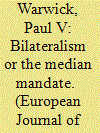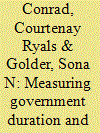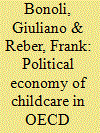|
|
|
Sort Order |
|
|
|
Items / Page
|
|
|
|
|
|
|
| Srl | Item |
| 1 |
ID:
094957


|
|
|
|
|
| Publication |
2010.
|
| Summary/Abstract |
Michael McDonald and Ian Budge have recently advanced an interpretation of democratic governance based on what they term the 'median mandate'. This perspective locates the key element of liberal democracy in a close correspondence between government policy and the policy preferences of the median voter on the left-right scale. The cross-national evidence they produce in favour of this interpretation is impressive, but it largely hinges on a method for measuring the median voter position in each election that relies on the positions of the various parties in the election and the vote shares they received. This article examines the validity of the median mandate hypothesis when median positions are measured more directly from public opinion surveys (particularly, the Eurobarometer and Comparative Study of Electoral Systems series). The findings show that choice between distinct alternatives, rather than conformity to the median, more accurately characterises governance in democratic systems.
|
|
|
|
|
|
|
|
|
|
|
|
|
|
|
|
| 2 |
ID:
094966


|
|
|
|
|
| Publication |
2010.
|
| Summary/Abstract |
Terrorism is an instrument for groups that cannot achieve their political goals legally. One important strategic function of terrorism is to weaken the government - either directly by attacking representatives or supporters of the government or indirectly by causing a political response that is unpopular among the population. Often, however, political stability of the home government is buttressed by foreign powers. In this case, the terrorists can have a strategic interest in attacking nationals of these foreign countries. This article analyses this logic by looking at international alliances as a proxy for international support. If the friend of my enemy is my enemy, then terror entrepreneurs, which seek to overthrow their home country's government (the enemy), may find it attractive to target nationals of the foreign allies of their country (the friends of the enemy). The theory in this article predicts that attacking nationals of a foreign ally is particularly attractive if this ally is militarily more powerful than the home country. Moreover, the combined effect of alliance and relative power differentials becomes stronger the more democratic the ally and becomes weaker the more democratic the terrorists' home country. Empirical support for the hypotheses in this article is found in an analysis of a directed country dyad sample of international terrorism.
|
|
|
|
|
|
|
|
|
|
|
|
|
|
|
|
| 3 |
ID:
094960


|
|
|
|
|
| Publication |
2010.
|
| Summary/Abstract |
The expansion of women's formal political representation ranks among the most significant trends in international politics of the last 100 years. Though women made steady political progress, substantial country-level variation exists in patterns of growth and change. In this article, longitudinal theories are developed to examine how political factors affect women's political representation over time. Latent growth curve models are used to assess the growth of women in politics in 110 countries from 1975 to 2000. The article investigates how electoral systems, national-level gender quotas and growth of democracy - both political rights and civil liberties - impact country-level trajectories of women's legislative representation. It is found: first, national quotas do affect women's political presence, but at a lower level than legislated by law; second, the impact of a proportional representation system on women's political representation is steady over time; and third, democracy, especially civil liberties, does not affect the level of women's political representation in the earliest period, but does influence the growth of women's political representation over time. These findings both reinforce and challenge prior cross-sectional models of women's political representation.
|
|
|
|
|
|
|
|
|
|
|
|
|
|
|
|
| 4 |
ID:
094965


|
|
|
|
|
| Publication |
2010.
|
| Summary/Abstract |
Anticipation is a central feature of political behaviour. It has an impact on actors' choices and can change the timing of decisions. This article analyses anticipation in legislative politics. After delineating different objects as well as consequences of anticipation theoretically, a set of hypotheses about anticipatory behaviour in EU decision-making is derived. In particular, it is asked whether the EU Council anticipates the arrival of new Member States and how this affects legislative output. The theory is tested by estimating count models using a dataset that contains information on all binding EU legislation from 1976 to 2007. Covering five enlargement rounds, evidence is presented for anticipatory behaviour in EU legislative politics.
|
|
|
|
|
|
|
|
|
|
|
|
|
|
|
|
| 5 |
ID:
094968


|
|
|
|
|
| Publication |
2010.
|
| Summary/Abstract |
Existing studies of government duration in parliamentary democracies typically measure the length of a government's tenure in office without accounting for delays in the government formation process. By assuming that a cabinet leaves office on the day prior to the new cabinet taking office, these measures ignore periods during which a government has lost its mandate but is still legally in power as a caretaker government. A consequence is that governments that are actually stable and governments that only appear stable because replacement governments take a long time to form are observationally equivalent. This suggests that some existing studies of government stability are potentially flawed. It also means that a number of interesting research questions cannot be answered with existing data. Many of these questions address the various consequences of caretaker governments. The answers to these questions are relevant for scholars interested in representation and accountability. This article presents a new dataset collected on government duration in eleven Central Eastern European democracies from 1990 to 2008 that specifically takes account of caretaker periods and delays in the government formation process. These data will provide scholars with more flexibility to choose the measure that best reflects their underlying conception of government stability.
|
|
|
|
|
|
|
|
|
|
|
|
|
|
|
|
| 6 |
ID:
094967


|
|
|
|
|
| Publication |
2010.
|
| Summary/Abstract |
If childcare policy has become topical in most OECD countries over the last ten years or so, actual developments display huge cross-national variations. Countries like Sweden and Denmark spend around 2 per cent of GDP on this service, and provide affordable childcare places to most children below school age. At the other extreme, in Southern Europe, only around 10 per cent of this age group has access to formal daycare. Against this background, this article aims to account for cross-national variations in childcare services. It distinguishes two dependent variables: the coverage rate and the proportion of GDP spent subsidising childcare services. Using a mix of cross-sectional and pooled times-series methods, it tests a series of hypotheses concerning the determinants of the development of this policy. Its main conclusion for the coverage rate is that key factors are public spending and wage dispersion (both positive). For spending, key factors are the proportion of women in parliaments (positive) and spending on age-related policies (negative).
|
|
|
|
|
|
|
|
|
|
|
|
|
|
|
|
|
|
|
|
|